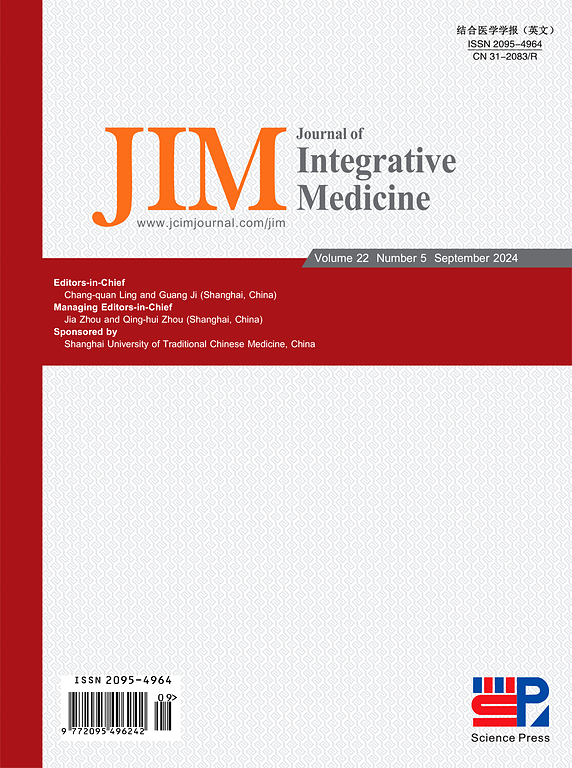Electroacupuncture for hot flashes in early menopause: A randomized sham-controlled trial
IF 4
2区 医学
Q1 INTEGRATIVE & COMPLEMENTARY MEDICINE
引用次数: 0
Abstract
Background
Electroacupuncture (EA) may affect the severity of hot flashes (HFs) associated with natural menopause and provide additional benefits for postmenopausal women. However, the evidence for its effectiveness in the management of early postmenopausal HFs remains inadequately understood.
Objective
We designed this trial to assess the efficacy and safety of EA for relieving early postmenopausal HFs.
Design, setting, participants and interventions
This randomized sham-controlled trial involved 72 women with HFs. The participants were divided equally into the intervention and control groups. The intervention group was treated with EA, while the control group was treated with sham acupuncture. The main acupoints used were Hegu (LI4), Guanyuan (RN4), Sanyinjiao (SP6), Taixi (KI3), Fuliu (KI7) and Shenshu (BL23). All participants received 18 treatment sessions, distributed across a 6-week period. The treatment was administered on three occasions per week, adhering to a fixed weekday schedule (Monday, Wednesday, Friday or Tuesday, Thursday, Saturday) with a minimum interval of one day between sessions. Each patient received a 12-week follow-up.
Main outcome measures
The HF score was the primary outcome. Participants documented the frequency and severity of HFs in a 7-day symptom diary, which provided data for calculating the HF score. Secondary outcomes were the Menopause Rating Scale (MRS), Menopause-Specific Quality of Life Questionnaire (MENQOL), Pittsburgh Sleep Quality Index (PSQI) and Traditional Chinese Medicine Syndrome Score Scale (TCMSSS), as well as estradiol (E2), luteinizing hormone (LH) and follicle-stimulating hormone (FSH) levels.
Results
Both groups demonstrated significant reductions in HF scores after the treatment and during the follow-up (P < 0.001). Immediately after completion of the 6-week treatment cycle and at 12 weeks post-intervention, the HF scores were similar in both groups. At week 6, the intervention group showed significantly greater improvements in MRS, MENQOL (vasomotor, psychosocial, and physical), PSQI and TCMSSS scores (P < 0.05). The improvements in the MENQOL (vasomotor, and psychosocial) and PSQI total scores persisted through the follow-up (P < 0.05). However, the results showed no significant inter- or intragroup differences in sexual scores on the MENQOL (P > 0.05). EA did not significantly decrease E2, LH or FSH levels compared to placebo. The incidence of adverse events was similar in both groups.
Conclusion
EA does not significantly improve HFs in early postmenopausal patients. However, it enhances the quality of sleep and decreases menopausal symptoms across vasomotor, psychosocial and physical domains.
Trial registration: Chinese Clinical Trial Registry (http://www.chictr.org.cn); Trial ID: ChiCTR2300072002.
Please cite this article as: Wang HX, Yu XT, Hu J, Chen JJ, Mei YT, Chen YF. Electroacupuncture for hot flashes in early menopause: A randomized sham-controlled trial. J Integr Med. 2025; 23(5):519–527.
电针治疗更年期早期潮热:一项随机假对照试验。
背景:电针(EA)可能影响与自然绝经相关的潮热(HFs)的严重程度,并为绝经后妇女提供额外的益处。然而,其在早期绝经后HFs管理中的有效性的证据仍不充分了解。目的:我们设计了这项试验,以评估EA缓解绝经后早期hf的有效性和安全性。设计、设置、参与者和干预措施:这项随机的假对照试验涉及72名患有hf的女性。参与者被平均分为干预组和对照组。干预组采用电针治疗,对照组采用假针刺治疗。主要穴位为合谷穴(LI4)、官园穴(RN4)、三阴角穴(SP6)、太溪穴(KI3)、扶柳穴(KI7)、肾俞穴(BL23)。所有参与者接受了18次治疗,分布在6周的时间内。治疗每周进行三次,坚持固定的工作日时间表(周一,周三,周五或周二,周四,周六),每次治疗之间至少间隔一天。每位患者接受为期12周的随访。主要观察指标:HF评分为主要观察指标。参与者在7天的症状日记中记录HF的频率和严重程度,这为计算HF评分提供了数据。次要观察指标为绝经评定量表(MRS)、绝经期生活质量问卷(MENQOL)、匹兹堡睡眠质量指数(PSQI)和中医证候评分量表(TCMSSS),以及雌二醇(E2)、黄体生成素(LH)和促卵泡激素(FSH)水平。结果:两组治疗后及随访期间HF评分均有显著降低(P < 0.05)。与安慰剂相比,EA没有显著降低E2、LH或FSH水平。两组不良事件发生率相似。结论:EA对早期绝经后患者的HFs无显著改善作用。然而,它提高了睡眠质量,减少了血管舒缩、心理社会和身体领域的更年期症状。试验注册:中国临床试验注册中心(http://www.chictr.org.cn);试用号:ChiCTR2300072002。这篇文章的署名是:王红霞,于小涛,胡洁,陈静杰,梅玉婷,陈玉峰。电针治疗更年期早期潮热:一项随机假对照试验。集成医学[J];打印前Epub。
本文章由计算机程序翻译,如有差异,请以英文原文为准。
求助全文
约1分钟内获得全文
求助全文
来源期刊

Journal of Integrative Medicine-Jim
Medicine-Complementary and Alternative Medicine
CiteScore
9.20
自引率
4.20%
发文量
3319
期刊介绍:
The predecessor of JIM is the Journal of Chinese Integrative Medicine (Zhong Xi Yi Jie He Xue Bao). With this new, English-language publication, we are committed to make JIM an international platform for publishing high-quality papers on complementary and alternative medicine (CAM) and an open forum in which the different professions and international scholarly communities can exchange views, share research and their clinical experience, discuss CAM education, and confer about issues and problems in our various disciplines and in CAM as a whole in order to promote integrative medicine.
JIM is indexed/abstracted in: MEDLINE/PubMed, ScienceDirect, Emerging Sources Citation Index (ESCI), Scopus, Embase, Chemical Abstracts (CA), CAB Abstracts, EBSCO, WPRIM, JST China, Chinese Science Citation Database (CSCD), and China National Knowledge Infrastructure (CNKI).
JIM Editorial Office uses ThomsonReuters ScholarOne Manuscripts as submitting and review system (submission link: http://mc03.manuscriptcentral.com/jcim-en).
JIM is published bimonthly. Manuscripts submitted to JIM should be written in English. Article types include but are not limited to randomized controlled and pragmatic trials, translational and patient-centered effectiveness outcome studies, case series and reports, clinical trial protocols, preclinical and basic science studies, systematic reviews and meta-analyses, papers on methodology and CAM history or education, conference proceedings, editorials, commentaries, short communications, book reviews, and letters to the editor.
Our purpose is to publish a prestigious international journal for studies in integrative medicine. To achieve this aim, we seek to publish high-quality papers on any aspects of integrative medicine, such as acupuncture and traditional Chinese medicine, Ayurveda medicine, herbal medicine, homeopathy, nutrition, chiropractic, mind-body medicine, taichi, qigong, meditation, and any other modalities of CAM; our commitment to international scope ensures that research and progress from all regions of the world are widely covered. These ensure that articles published in JIM have the maximum exposure to the international scholarly community.
JIM can help its authors let their papers reach the widest possible range of readers, and let all those who share an interest in their research field be concerned with their study.
 求助内容:
求助内容: 应助结果提醒方式:
应助结果提醒方式:


